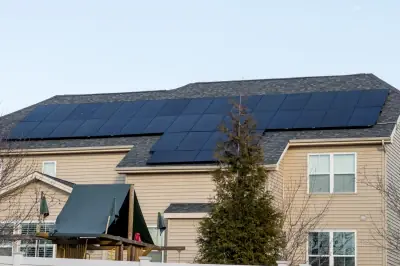Solar panel financing add-on loans California
Your utility bills average $300 monthly. Solar could eliminate 90% of those costs. Installation quotes range from $25,000 to $40,000. Solar loan companies offer 8-12% interest rates. Your mortgage rate is 6.5%. Meanwhile, the 30% federal tax credit drops to 26% on January 1, 2026 - act before year-end to capture the extra 4%.
Solar panel financing add-on loans solve the timing and cost problem. Instead of separate high-rate solar loans, these programs integrate renewable energy costs into your mortgage at lower rates while capturing expiring tax benefits.
California leads the nation in solar adoption, but financing challenges prevent many homeowners from accessing renewable energy benefits. Solar add-on financing removes these barriers through integrated mortgage solutions.
Solar Panel Add-On Loans - Green Energy Integration
Solar panel financing add-on loans enable homeowners to finance renewable energy systems through their primary mortgage, combining long-term home financing with green energy investments at optimal rates.
The fundamental advantage involves accessing mortgage rates for solar financing rather than higher personal loan rates typically offered by solar installers or specialized renewable energy lenders.
These programs recognize that solar installations represent permanent property improvements that increase home values and reduce ongoing operating costs, justifying their inclusion in mortgage financing.
Energy Efficient Mortgage (EEM) programs provide the regulatory framework for including renewable energy costs in home financing while staying within standard lending guidelines.
Why Is Federal Solar Tax Credit Urgency Important in California?
The 30% federal solar tax credit decreases to 26% on January 1, 2026, representing a 4-percentage-point reduction in available tax benefits for solar installations.
Tax credit value reaches $10,500 on a $35,000 solar installation at the 30% rate (through 2025), versus $9,100 at the 26% rate (starting 2026). Installing before year-end captures the extra $1,400 in tax savings when combined with mortgage rate financing.
Energy Efficient Mortgage Programs
Energy Efficient Mortgages allow borrowers to finance renewable energy improvements up to 15% above standard loan limits, providing substantial additional financing capacity for solar installations.
Fannie Mae and Freddie Mac both support energy efficient lending through programs that recognize the value of renewable energy improvements in home financing decisions.
FHA’s Energy Efficient Mortgage program enables borrowers to include energy improvements in their loan amount, with the understanding that energy savings help offset additional mortgage payments.
VA loans also accommodate energy efficient improvements, allowing veterans to finance solar systems through their home loans with competitive terms and no down payment requirements.
These are general guidelines - exceptions exist. Give us a call because we can usually work around these guidelines with the right lender match.
What Loan Limit Enhancements Apply to Solar Panel Financing?
Standard conforming loan limits can be exceeded by up to 15% for energy efficient improvements, potentially adding $100,000+ in solar financing capacity for high-value California homes. Consider jumbo loans in California for high-value.
This enhanced borrowing capacity enables comprehensive solar installations including battery storage systems that maximize energy independence and utility savings.
California’s Solar Market Opportunity
California’s abundant sunshine and high electricity costs create optimal conditions for solar energy adoption, with many installations achieving 8-12 year payback periods through utility savings alone.
State incentives complement federal tax credits, though many California programs focus on low-income households or specific utility territories with varying availability and requirements.
High electricity rates throughout California make solar installations particularly attractive, with Tier 3 and Tier 4 usage rates often exceeding $0.40 per kWh in peak periods.
Net metering programs allow homeowners to sell excess solar production back to utilities, creating additional value streams that improve overall solar investment returns.
What Regional Market Factors Affect Solar Financing in California?
Northern California utility rates and net metering policies differ from Southern California Edison and San Diego Gas & Electric territories, affecting optimal solar system sizing and economic returns.
Understanding local utility structures helps optimize solar installations for maximum economic benefit when integrated with mortgage financing programs.
System Ownership Requirements
Solar add-on financing requires system ownership rather than leasing arrangements, ensuring the solar equipment becomes permanent property that can be included in mortgage financing.
Owned systems provide full access to federal and state tax credits while contributing to property value increases that support mortgage lending decisions. Major home improvements through renovation loans often pair well with solar installations for comprehensive property upgrades.
Leased systems cannot be financed through mortgages since the equipment belongs to third-party leasing companies rather than the homeowner.
Ownership benefits include full control over system maintenance, upgrade decisions, and the ability to benefit from all tax incentives and utility savings without sharing with leasing companies.
What Equipment and Installation Standards Apply to Solar Mortgage Financing?
Solar systems must meet professional installation standards including proper permitting, code compliance, and utility interconnection requirements for mortgage lending acceptance. Properties with unpermitted additions may need those issues resolved before adding solar panel liens.
Licensed contractor installation ensures systems meet building codes and safety standards while providing warranties that protect the mortgage lender’s collateral interest. Consider bank statement loans for contractor.
Interest Rate and Cost Advantages
Mortgage financing typically provides solar system financing at rates 3-6% lower than dedicated solar loans, creating substantial savings over 20-30 year financing periods.
Current mortgage rates around 6-7% compare favorably to solar loan rates of 8-12%, potentially saving thousands in interest costs over the loan term.
Monthly payment optimization often results in energy savings that exceed the additional mortgage payment, creating positive monthly cash flow from solar installations.
Long-term financing spreads solar costs over 30 years rather than 10-20 year solar loan terms, reducing monthly payment impact while maintaining positive cash flow benefits.
How Do You Analyze Total Cost of Ownership for Solar Financing?
Combining lower mortgage rates with federal tax credits and utility savings creates compelling economics for solar adoption through add-on financing programs.
Professional energy analysis helps homeowners understand total solar economics including financing costs, tax benefits, and utility savings over the system lifetime.
Property Value Enhancement
Solar installations typically increase home values by 3-4% according to multiple studies, with buyers increasingly valuing homes with renewable energy systems and lower utility costs.
Appraisal recognition of solar value ensures mortgage amounts reflect the full improved property worth, supporting the additional financing required for system integration.
Real estate markets increasingly recognize solar as a valuable amenity, with homes featuring solar systems often selling faster and at premium prices compared to similar homes without renewable energy.
Market differentiation becomes particularly valuable in California’s competitive real estate markets where energy efficiency and environmental features appeal to many buyers.
What Long-Term Investment Value Do Solar Panels Provide in California?
Solar systems provide 25+ year utility savings that enhance long-term property ownership economics while contributing to resale value for future property transfers.
Understanding solar investment returns helps homeowners evaluate whether mortgage integration provides optimal financing compared to alternative approaches.
Rates change daily based on your credit, down payment, and property type. Contact us for your personalized rate quote.
Installation Coordination and Timeline
Solar add-on financing requires coordination between mortgage closing and solar installation timelines to ensure proper documentation and system activation.
Construction timeline planning ensures solar installation occurs promptly after mortgage closing while meeting utility interconnection deadlines and permit requirements.
Some programs allow mortgage closing before solar installation completion, while others require system completion before final loan funding to ensure collateral protection.
Professional coordination between mortgage lenders, solar installers, and utility companies ensures smooth project completion without delays or complications.
How Does the Process Work?
California utilities have specific interconnection requirements and timelines that affect when solar systems become operational and begin generating savings and tax credit eligibility.
Understanding utility processes helps plan realistic timelines for system activation and benefit realization when using mortgage financing for solar installations.
Battery Storage Integration
Advanced solar installations often include battery storage systems that enhance energy independence while qualifying for additional tax credits and utility programs.
Battery storage financing can be included in solar add-on loans since storage systems provide backup power and energy management benefits that enhance property value.
California’s time-of-use utility rates make battery storage particularly valuable for optimizing solar energy usage and minimizing peak-period electricity purchases. Consider purchase loan options for purchase.
Grid independence benefits become increasingly important during California’s fire season power shutoffs and other utility reliability challenges.
What Technology Advancement Considerations Affect Solar Panel Financing?
Rapidly evolving solar and battery technology requires balancing current system installation with future upgrade possibilities when using long-term mortgage financing.
Professional energy consultants help homeowners select systems that provide optimal current benefits while maintaining flexibility for future technology improvements.
GoGreen Home Financing Program
California’s GoGreen Home program provides credit enhancements for clean energy technologies including bundled solar and battery storage systems through participating lenders.
Credit enhancement benefits enable lenders to offer lower rates, longer terms, and higher loan amounts while approving broader borrower populations for energy upgrade financing.
The program specifically supports solar installations combined with other energy improvements including heat pump systems, EV charging, and energy efficiency upgrades.
State support helps make renewable energy more accessible through improved financing terms compared to standard mortgage programs.
What Are the Key Benefits?
GoGreen Home participation can result in rate reductions and enhanced qualification flexibility for California homeowners pursuing solar installations through mortgage financing.
Understanding program availability and lender participation helps optimize solar financing terms for maximum economic benefit.
Professional Guidance and Coordination
Solar add-on financing success requires coordination between mortgage professionals, solar installers, and energy consultants to optimize system design and financing integration.
Experienced mortgage specialists understand energy efficient mortgage programs and can guide borrowers through the coordination required for successful solar financing integration.
Solar system design should consider both energy production optimization and mortgage lending requirements to ensure systems qualify for financing integration.
Professional energy analysis helps homeowners understand total project economics including financing costs, tax benefits, utility savings, and long-term value creation.
What Integrated Service Approach Works Best for Solar Financing?
Comprehensive solar financing services coordinate all aspects of renewable energy adoption from system design through mortgage integration and tax credit optimization.
This integrated approach ensures optimal outcomes while minimizing complexity and coordination challenges for homeowners pursuing solar energy adoption.
Next Steps for Solar Financing Success
Solar panel financing add-on loans provide California homeowners with optimal access to renewable energy through mortgage integration. Installing by December 31, 2025 captures the maximum 30% federal tax credit before it decreases to 26% in 2026.
Our green energy financing specialists understand both mortgage lending and solar market dynamics to provide comprehensive guidance for renewable energy adoption through mortgage integration.
Every solar financing situation involves unique energy needs, property characteristics, and financial objectives. Call (510) 589-4096 to explore solar financing options or view all niche program options.
Explore More Niche Programs
Not sure if solar financing fits your situation? Compare our other niche program options including large acreage programs (rural properties), LLC funding (business entity financing), and buy before you sell loans (bridge financing) to find the perfect solution for your California home financing needs.


